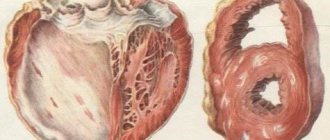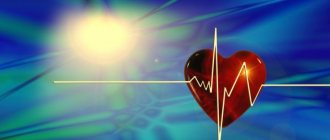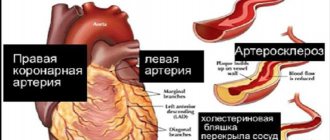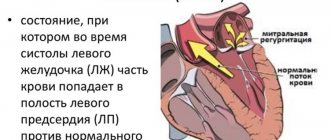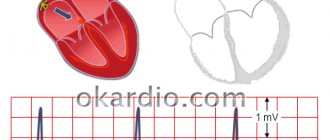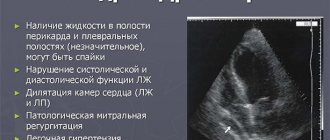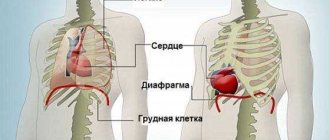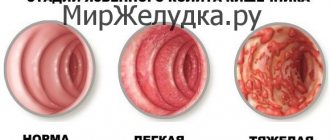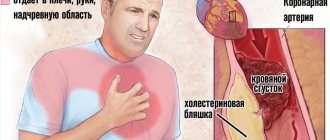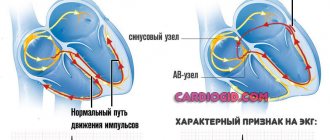- What is aortocardiosclerosis?
- Kinds
- Reasons for the development of pathology
- Symptoms of the disease
- Complications
- Diagnostics
- Treatment of aortocardiosclerosis (cardiosclerosis)
- Prevention
- Forecast
Aortocardiosclerosis is a disease in which the heart muscle tissue is replaced by scar tissue, causing cardiac function to be impaired, the number of cardiomyocytes (muscle cells of the heart) to decrease, and the heart valves to gradually become deformed, leading to heart failure or stenosis.
What is aortocardiosclerosis?
Aortocardiosclerosis is an outdated term that is no longer used in medicine due to the transition to the international classification of diseases. At the moment, the official name of this disease is cardiosclerosis .
If damage to the heart muscle cells occurs, dense scar tissue consisting of connective tissue begins to grow at the site of these defects. Such tissue cannot perform the functions necessary for the heart.
At first, the remaining and healthy cells also do the work for the damaged cells, but over time their nutrition is disrupted, which leads to death and scarring.
The more scar tissue becomes, the faster the heart muscle loses its ability to work, the heart rhythm is disrupted (due to the fact that the damaged areas of the muscle cannot distribute contraction control impulses that come from the brain) and contractile function is lost.
Treatment of atherosclerosis: what is the price
We are proud of our clinic because we provide quality services to patients. We employ highly qualified specialists and use modern equipment. Call us and find out how atherosclerosis is treated and what the prices are. Consultants will answer all questions.
Attention! You can cure this disease for free and receive medical care at JSC "Medicine" (clinic of Academician Roitberg) under the State Guarantees program of Compulsory Medical Insurance (Compulsory Medical Insurance) and High-Tech Medical Care. To find out more details, please call or visit the VMP page for compulsory medical insurance
Kinds
Depending on the primary diseases, due to which the process of replacing healthy tissue with scar tissue began, the following types of cardiosclerosis are distinguished:
- Atherosclerotic - develops against the background of coronary heart disease, occurs at any age, even in children, in cases of infectious diseases such as measles, etc. Also, such inflammation is caused by allergies or chronic diseases. The process of development of the atherosclerotic form can last for years and for quite a long time the patient may not feel any manifestations of the disease. But, after a while, heart failure develops.
- Post-infarction – is a consequence of a person’s recovery after a myocardial infarction. In case of recurrence of heart attacks, scars of varying length and location appear. They can close together or be isolated. The cavities of the heart expand and, under the influence of systolic pressure, scar lesions can begin to stretch, which leads to the appearance of an aneurysm, the rupture of which leads to death.
- Postmyocardial – is a consequence of various diseases (purulent tonsillitis, sinusitis, rheumatism) that cause an inflammatory response in the myocardium. It may occur in both adults and children.
The cicatricial process can spread throughout the myocardium to a greater or lesser extent, taking into account the fact that there are two main types of cardiosclerosis:
- diffuse cardiosclerosis;
- focal cardiosclerosis.
Features of the diffuse process
Diffuse cardiosclerosis can spread throughout the entire myocardium or occupy only some part and there will be no clear boundaries. The developmental structure of this form is cellular, which includes areas of normal muscle tissue.
Gradually, these areas decrease in size, but the connective tissue does not completely replace them. Scar formation cannot contract, but is formed on the basis of destroyed cardiomyocytes.
Features of the focal process
Focal cardiosclerosis is a limited area of scar tissue with clear boundaries that forms in place of dead cardiac tissue. In another way, focal cardiosclerosis can be called a scar on the heart - it completely lacks the muscle cells of the heart, which is why it cannot contract and weakly transmits impulses.
Depending on the size of the lesion, the following types of disease are distinguished:
- Wide-focus - a large focus is formed due to blockage of a large coronary vessel, which is why all cardiomycytes die. This type of disease is mainly characterized by the proliferation of collagen fibers and other connective elements at the site of the infarction. As a result, a scar appears that prevents an aneurysm from forming.
- Fine-focus - muscle tissue changes slightly, white layers of connective tissue are formed, which are located inside the myocardium. The cause of microfocal cardiosclerosis is a lack of oxygen in the walls of the heart chambers, which leads to a decrease in the number and death of cardiomyocytes.
Reasons for the development of pathology
Cardiosclerosis is a secondary disease, since it is always preceded by pathological lesions of the heart, which include:
- Heart attack , due to which part of the heart muscle dies.
- Vascular calcification is the formation of plaques on the walls of blood vessels that block the lumen.
- Coronary artery disease - aggravates the already impaired functioning of the heart and increases the area of myocardial damage, which is why cardiosclerosis becomes more extensive.
- Hypertension - causes degeneration, destruction and sclerotization of areas of the myocardium that could not withstand the overload due to high pressure.
- Myocardial dystrophy is damage to the heart muscle, which is associated with a violation of the metabolic processes of the myocardium.
- Atherosclerosis - hemodynamics worsen, necrosis of cardiac tissue occurs and the scarring process is activated due to vascular damage.
- Diabetes mellitus - oxygen starvation develops as a result of damage to small vessels, which causes the destruction of cardiomyocytes and their replacement with connective tissue.
Factors that can cause cardiosclerosis to develop include:
- excess weight;
- a lot of stress;
- insufficient amount of physical activity;
- poor nutrition;
- avitaminosis;
- hereditary factor;
- overeating.
Risk factors for atherosclerosis
The main factors contributing to the development of plaques are considered to be smoking, arterial hypertension and lipid metabolism disorders. Additional factors that help and aggravate: age, diabetes, obesity, sedentary lifestyle, unhealthy diet, hereditary predisposition, and in women also postmenopausal age. Factors whose influence on the development of the disease in a particular person can be excluded are called modifiable, and in atherosclerosis they are the majority. But it is impossible to exclude the influence of age, heredity and gender; these are non-modifiable factors.
The leading and fundamental cause of the disease is smoking. Tobacco contains several hundred harmful substances and compounds, not just the drug nicotine. It has been proven that giving up this not just harmful, but destructive habit significantly reduces the risk of developing atherosclerosis, and with it all cardiovascular diseases.
An increase in the level of cholesterol and “bad cholesterol” LDL, which is called hyperlipidemia, contributes to their deposition in the choroid. In studies, reducing the level of “bad cholesterol” by 1.0 mmol/L reduced mortality from CVD by 22%. Cholesterol can be partially corrected by diet; remember, only 20% comes from food. The remaining 80% of cholesterol is synthesized by the body according to the genetic program; this amount of cholesterol must be reduced with special drugs - statins. Cholesterol levels depend on diet, physical activity and even the season; in winter it is higher, but “good” cholesterol is also higher at this time of year.
Arterial hypertension is so closely related to atherosclerosis that both diseases can be considered twins. Some scientists consider both diseases to be different sides of a single process, where one pathological condition necessarily turns into another, and it doesn’t matter which one was legalized first, the main thing is that both are together and pull each other. With a prolonged increase in pressure, spastic narrowing of the vessel contributes to the formation of an atherosclerotic plaque in it; atherosclerosis narrows the vessels, contributing to an increase in pressure. Plaques “like” to form in the forks of the vessel into branches, where turbulent waves of blood supplied under high pressure strike.
Obesity is inherently a voluminous manifestation of excess cholesterol and metabolic disorders. It is necessary to understand that a man's waist should be no more than 94 cm, and a woman's - less than 80 cm, and this is not a desire for beauty, but a vital necessity. Losing 10 kg of weight reduces the level of “bad cholesterol” by 0.2 mmol/l, while increasing insulin sensitivity and decreasing triglyceride levels.
Do not forget that excess body weight leads to physical inactivity - a decrease in physical activity, which in turn directly leads to atherosclerosis. Physical activity reduces LDL concentrations.
Excess fat in the diet directly affects atherogenesis, promotes obesity, which leads to the development of diabetes. With a lack of vitamin E and essential phospholipids from dietary fats, the synthesis of “good cholesterol” is disrupted. Therefore, moderation is important in everything.
With type 2 diabetes, which usually develops in adults, the risk of death from heart disease increases threefold in men and fivefold in women. And cardiovascular diseases are a clinical manifestation of atherosclerosis. In diabetes mellitus, small vessels are necessarily damaged, which is called “microangiopathy,” and later larger arteries are also involved - a complete blessing for creating plaques on the unsmooth lining of already narrowed vessels.
You can’t easily overcome a hereditary predisposition, but now genetic testing makes it possible to diagnose familial hyperlipidemia and other deviations from normal lipid metabolism in order to promptly begin lifelong correction with the help of medications.
Make an appointment with a cardiologist today
Symptoms of the disease
The manifestation of symptoms does not depend on cardiosclerosis itself, but on the disease that caused it. The main signs of the disease are:
- the appearance of a suffocating cough at night, the so-called “cardiac asthma”;
- pain in the right hypochondrium due to a liver full of blood;
- shortness of breath in any position;
- strong heartbeat;
- swelling, the appearance of which indicates the severity of the disease;
- tachycardia, extrasystole and bradycardia;
- decreased performance;
- dizziness;
- fatigue.
The severity of symptoms depends on the degree of distribution of scar tissue in relation to healthy tissue - the more scars, the stronger the heart failure and its symptoms. If scarring is present in small, isolated areas, this may indicate a complete absence of symptoms.
The progression of cardiosclerosis occurs gradually, remissions are possible that last 2-3 years.
Contraindications for atherosclerosis
Atherosclerosis is dangerous because it has a number of contraindications. The manifestations of the disease are not always easy to eliminate. Thanks to the possibility of conservative and surgical treatment, the likelihood of getting rid of the disease is high. But there are still contraindications for atherosclerosis:
- the presence of acute forms of disease;
- allergies to drugs;
- circulatory failure;
- myocarditis in active form.
If there are conditions that prevent the elimination of the disease, alternative methods are selected.
Diagnostics
Diagnosis of cardiosclerosis begins with collecting patient complaints. The doctor also takes into account all diseases that were previously suffered and analyzes the degree of heart failure.
The patient is examined for the presence of swelling of the extremities, the abdomen is palpated, tapped, the accumulation of fluid is determined, how much the liver has enlarged. Blood pressure and pulse are also measured and the chest is auscultated.
Hardware methods for diagnosing the disease include:
- echography of the heart - determines the size of the parts of the heart, its pumping function, contractile capabilities;
- computed tomography or magnetic resonance imaging;
- scintigraphy is a non-invasive method for studying the myocardium - a substance with radioactive isotopes is injected into the patient’s vein, which circulate throughout the body and are absorbed by the myocardium, after which, using a gamma camera, its distribution in the heart muscle is analyzed;
- electrocardiogram – evaluates the automaticity, conductivity and excitability of the heart;
- X-ray - in the pictures you can see an increase in the chambers of the heart;
- Holter monitoring – is a recording of a regular electrocardiogram and blood pressure during the day when the patient is engaged in normal physical activity.
Laboratory methods used:
- general blood biochemistry;
- blood test for cholesterol;
- general urine analysis.
Treatment of aortocardiosclerosis (cardiosclerosis)
There is no treatment that can reverse the process of scar tissue formation, so what treatment is available has several goals:
- carry out therapy for the disease that led to the development of cardiosclerosis;
- ensure the preservation of working capacity and improvement of the patient’s quality of life.
Cardiosclerosis is treated with medications and surgery. The selection of a treatment strategy depends on the nature and severity of the disease, the age of the patient, drug intolerance, and general health.
Drug therapy
Drug treatment includes the following drugs:
- diuretics - necessary to remove excess fluid from the body, thereby relieving the load on the heart muscle (Lasix, Furosemide, Hypothiazide, Indapamide);
- beta blockers - block receptors that respond to adrenaline and norepinephrine (Metoprolol, Nebivolol, Propraponolol, Bisoprolol);
- ACE inhibitors - dilate blood vessels, increase blood supply to the myocardium and its contractility (Enap N, Berlipril Plus, Liprazide);
- cardiac glycosides - drugs that help increase the strength of the heart muscle (Digoxin);
- angiotensin receptor antagonists of the first and second types - prescribed in case of intolerance to ACE inhibitors - dilate blood vessels, thereby lowering blood pressure;
- statins – prescribed to slow down atherosclerosis of the coronary vessels (Simvastatin, Atoris);
- blood thinners (Cardiomagnyl, Lospirin, Clopidogrel, Magnicor);
- vitamins and minerals (vitamin A, group B, Omega-3).
Surgery
Surgeries for cardiosclerosis help eliminate complications or cure the primary pathology that caused the development of the disease. If there is severe bradycardia, the patient may be implanted with a pacemaker - a device that will set the rhythm of the heart using electrical impulses.
In case of severe myocardial ischemia, which was caused by blockage of the coronary arteries, stenting is prescribed. If this operation is not possible, the cardiac surgeon performs coronary artery bypass grafting.
A severe surgical option for cardiosclerosis is a heart transplant. Nowadays, there are cases of treating a disease with the help of stem cells, however, due to the high cost and ambiguous results, the use of this technique remains in question.
Traditional methods
Folk remedies are not a panacea, however, they can help alleviate symptoms and prevent the development of severe complications. The best traditional medicine recipes include:
- Garlic. Affects cholesterol levels. To make the tincture, you need to crush the garlic using a press and mix with lemon juice and water.
- Parsley is a source of minerals that are needed for proper functioning of the heart muscle. Parsley can be added to salads or consumed as a decoction.
- Artichoke extract – raises the level of good cholesterol and removes excess bad cholesterol. It can be consumed in the form of capsules, tablets and tinctures.
- A collection of caraway and hawthorn. Take 1 tsp. caraway fruits and 1 tbsp. l. hawthorn root. Grind and mix. Boil 300 ml of boiling water, let it brew overnight in a thermos and strain. Drink during the day in 4-5 doses.
Diet food
A proper diet plays a big role in improving the nutrition of myocardial areas. The main nuances when creating a menu are:
- replace animal fats with vegetable fats - this will reduce the amount of cholesterol in the blood;
- replace simple carbohydrates with complex ones;
- give up alcohol;
- reduce the amount of salt you consume;
- add more vegetables and fruits to your menu that contain antioxidants;
- eat fish, as it contains omega-3 polyunsaturated fatty acids;
- add more soluble dietary fiber.
Which doctor treats atherosclerosis
Atherosclerosis is a serious disease, most people are at risk. Every second person on the planet is susceptible to atherosclerosis, but not everyone knows which doctor deals with problems with blood vessels. After all, the presence of such a diagnosis implies heart problems, disruption of the aorta, and even the legs suffer. Let's figure out which doctor treats atherosclerosis.
If you notice a change in the body, there are a number of factors that contribute to the appearance of such a disease as atherosclerosis, you should consult a therapist. He will be able to identify the first signs, conduct a basic examination and refer you to another doctor if necessary. Diagnosis is carried out by an angiologist, it is this doctor who specializes in this disease. The work is also carried out jointly with a neurologist. This specialist helps in the fight against atherosclerosis.
In our clinic, professional doctors with extensive experience help eliminate atherosclerosis of the arteries and damage to the aorta. We treat complex forms of vascular pathology; specialists reduce the risk of worsening health conditions. Choose your doctor and make an appointment.
Prevention
Prevention of cardiosclerosis includes the following measures:
- timely and complete therapy of the underlying disease;
- long and high-quality sleep;
- vitamin therapy;
- carrying out vaccination against influenza, diphtheria, rubella;
- compliance with doctor's prescriptions;
- avoiding excessive physical activity;
- compliance with the work and rest regime;
- proper nutrition.
Procedures used for cardiosclerosis:
- massage;
- radon, iodine-bromine baths;
- infrared sauna;
- physiotherapy;
- underwater shower-massage;
- dry carbon dioxide baths.
How is it diagnosed?
To confirm the diagnosis, a number of procedures are performed, which include an ultrasound examination of the heart.
Cardiosclerosis can be suspected by the presence of clinical signs characteristic of this disease in the patient. To confirm the diagnosis, it is recommended to conduct an ultrasound examination and magnetic resonance imaging of the heart, with the help of which areas of replacement of cardiomyocytes with connective tissue are determined. It is also necessary to conduct a chest x-ray and coronary angiography, which helps to identify changes in blood circulation. Electrocardiography and radioisotope study of the heart are indicated. It is important to take a general and biochemical blood test, as well as conduct immunological and hormonal studies.
Forecast
The diffuse form of cardiosclerosis is considered unfavorable in its prognosis. For example, with the formation of connective tissue at the site of a transmural infarction, the risk of developing an aneurysm increases, the rupture of which most often leads to immediate death. In cases where cardiosclerosis arose as a result of natural age-related changes, this course of the disease is usually favorable.
Cardiosclerosis is a common heart pathology, the severity of which depends on the volume of affected tissue and the general condition of the body. If a person notices symptoms of this disease, he should consult a doctor as soon as possible, who will examine him and prescribe therapy.
Clinical manifestations of atherosclerosis
Clinical manifestations are determined not so much by the extent of vessel involvement in the pathological process as by the specific localization of the plaque narrowing the lumen. And almost total closure of the vessel is not necessarily required; ischemia can occur with very moderate obliteration, for example, if the plaque is combined with an increase in pressure, as is known, caused by vasospasm.
As a rule, vascular beds are affected by atherosclerosis. When localized in the cerebral basin - the vessels of the brain - headaches, dizziness, noise in the head, memory and intellectual impairment develop. The apotheosis of cerebral atherosclerosis is ischemic stroke of the brain. Atherosclerotic damage to the blood vessels of the heart responds with angina pectoris, which at a critical moment becomes myocardial infarction.
Plaque damage to the renal artery will lead to increased blood pressure, and the starving kidney will decrease its functionality. If atherosclerosis of the renal artery occurs in parallel with the development of diabetic microangiopathy, then it is worth preparing for renal failure. In the arteries of the abdominal cavity affected by plaques, which are responsible for the blood supply to the intestines, blood clots can form, and the desolation of the vessel leads to ischemia of a segment of the intestine and even surgery for necrosis of the intestinal wall.
Atherosclerotic damage to the arteries of the lower extremities brings severe suffering to the male half of humanity, and all of them are heavy smokers. It starts, as always, small, but ends up with amputations as a result of critical ischemia of the limb. But even before amputation, the poor fellows are not allowed to sleep peacefully due to pain in their legs, not allowing them to take a horizontal position in bed, since the intensity of the pain syndrome increases significantly.
Atherosclerosis occurs secretly, but leads to suffering.
